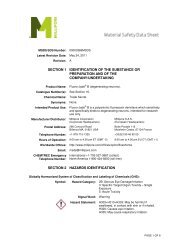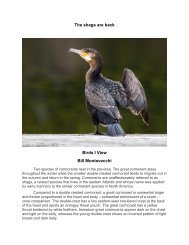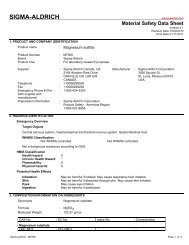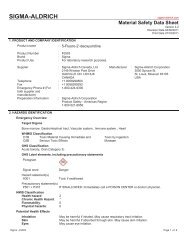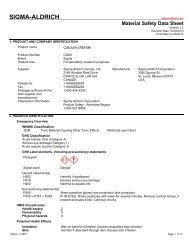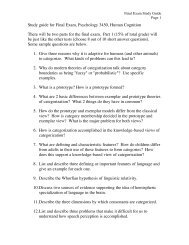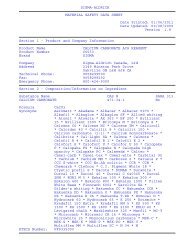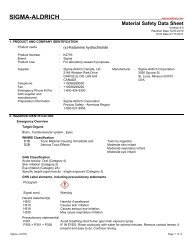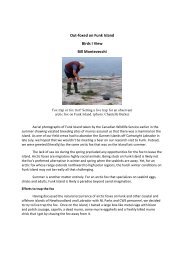Birds I View 108 -The return of harlequin ducks.pdf - Play Psych Mun
Birds I View 108 -The return of harlequin ducks.pdf - Play Psych Mun
Birds I View 108 -The return of harlequin ducks.pdf - Play Psych Mun
Create successful ePaper yourself
Turn your PDF publications into a flip-book with our unique Google optimized e-Paper software.
<strong>The</strong> <strong>return</strong> <strong>of</strong> the <strong>harlequin</strong> <strong>ducks</strong><strong>Birds</strong> I <strong>View</strong>Bill MontevecchiFemale Harlequin Duck with a smudge <strong>of</strong> oil on cheek, Branch - 6March 2009 (photo: Tony Power).<strong>The</strong> elegantly plumaged and robust little sea<strong>ducks</strong>, referred to as lords andladies, are a birdwatcher’s delight. Once an abundant duck in our coastal waters,a mounted <strong>harlequin</strong> duck was a hunter’s living room trophy. On a boat trip fromSt. Brides to Cape St. Mary’s in the 1950s, Les Tuck and Roger Tory Petersonobserved hundreds <strong>of</strong> <strong>harlequin</strong> <strong>ducks</strong> near Lears Cove.Subsequently, <strong>harlequin</strong> numbers plummeted to a low point <strong>of</strong> just a dozenbirds in Golden Bay in1990. Numbers were so low that the Eastern NorthAmerican population was designated as Endangered by COSEWIC (Committee onthe Status <strong>of</strong> Endangered Wildlife in Canada). Through research, educationaloutreach and conservation efforts like those carried out by Parks and Natural
Areas staff in the Cape St. Mary’s Ecological Reserve, the numbers <strong>of</strong> thesesea<strong>ducks</strong> have increased.Oiled <strong>harlequin</strong> and fulmarOn 6 March, Tony Power, Manager <strong>of</strong> the Cape St. Mary’s Reserve, called totell me that he had seen an oiled <strong>harlequin</strong> duck <strong>of</strong>f Branch. Later he found anoiled northern fulmar in Point Lance.<strong>The</strong>se are two unusual species to find oiled – the <strong>harlequin</strong> owing to itsrarity and the fulmar owing to its primarily <strong>of</strong>fshore distribution. We always try toassess what oiled birds can tell us about marine pollution.Harlequin duck surveyEach year in late winter, a systematic boat survey for <strong>harlequin</strong> <strong>ducks</strong> andother marine birds is run in and around the Cape St. Mary’s Ecological Reserve.After having seen the oiled <strong>harlequin</strong>, Tony was concerned and anxious to checkthe reserve and adjacent waters.With funding from the Friends <strong>of</strong> Cape St. Mary’s, this year’s survey andtook place on the glorious sunny day <strong>of</strong> 11 March. Owing to family commitments,I was not able to join in.At nearby Point Lance, there were 25 <strong>harlequin</strong> <strong>ducks</strong>. On the rockyoutcropped Bull and Calf, there were 56 <strong>harlequin</strong>s, 3,500 – 4,000 eiders, 142purple sandpipers and a snowy owl were at the Wester Bull. An immature baldeagle was at the Easter Bull.At Forthy Sunker, they counted 110 <strong>harlequin</strong>s, including 95 in flight. Twosmall flocks <strong>of</strong> 10 and 12 flew towards Cats Cove in Golden Bay. Two bald eagleswere perched on cliffs <strong>of</strong> Redland Point, below which there were another 57<strong>harlequin</strong>s – 40 hauled and 17 in the water. At Cats Cove Point, 117 <strong>harlequin</strong>swere counted, including 51 in flight, 31 hauled out plus another 35 hauled outLord and Lady Gulch. Nine <strong>harlequin</strong>s were in Wester Cove.To this point, the total <strong>harlequin</strong> count was 374. From this tally, Tonysubtracted the flocks <strong>of</strong> 10 and 12 that flew in from the Bull and Calf and another47 <strong>harlequin</strong>s that flew while they were counting. This left a total <strong>of</strong> 305 birds,well above the previous high survey count <strong>of</strong> 267 in 2007. But they were not doneyet.
From Golden Bay, Tony, Chris Mooney and crew headed out to the St.Mary’s Cays. Here they found 6,000 eiders. Amazingly, they counted anotherflying flock <strong>of</strong> 158 <strong>harlequin</strong> <strong>ducks</strong>! Tallied in with the 305 previously counted,their day total was 463 <strong>harlequin</strong> <strong>ducks</strong> – the single highest systematic count <strong>of</strong><strong>harlequin</strong> <strong>ducks</strong> ever made in Newfoundland and Labrador. At the day’s end, itappeared that Tony Power and Chris Mooney had matched or bettered the halfcentury old count <strong>of</strong> lords and ladies by Roger Tory Peterson and Les Tuck. Couldthere have ever been a finer day? Les and Roger are no doubt smiling about thisone.<strong>Birds</strong> in the area and around the provinceIn Carmanville, Ed Easton has been feeding some mallard <strong>ducks</strong> that arewintering on the ice in Noggin Cove. Good numbers <strong>of</strong> greater scaup and tufted<strong>ducks</strong> are at Quidi Vidi Lake and Burton’s Pond.During a Valentine’s Day beach survey for seabirds with a class fromMemorial, Tony Power observed 2 Ruddy Turnstones at Point LaHaye. We als<strong>of</strong>ound a number <strong>of</strong> freshly dead thick-billed murres that had no oil on them, whichwas less comforting than finding no dead birds but more comforting than finddead oiled birds. <strong>The</strong> remains <strong>of</strong> a gull coated with heavy black crude oil lookedto have been there for a while.On the beach at Portugal South, we found the carcass <strong>of</strong> a white-sideddolphin. A 15 cm crescent cut through the spinal cord just above the tailsuggested that a prop injury had caused the animal’s death. <strong>The</strong>se dolphins havebeen dying in a number <strong>of</strong> locations around the island recently.More than 50 carcasses <strong>of</strong> great black-backed gulls were counted on the iceat Quidi Vidi Lake. A provincial vet is attempting to determine the cause <strong>of</strong> thedie-<strong>of</strong>f that provided meals for scavenging eagles and gulls.On February 12, I noted 4 immature eagles scavenging on gull carcasses onthe ice at Quidi Vidi Lake. Earlier in the week, others had counted up to 10 eagleson the lake. During our beach survey around the southern Avalon from St. Mary’sBay to St. John’s we noted 7 bald eagles mostly adults. Might a higher proportion<strong>of</strong> immature gulls remain in the vicinity <strong>of</strong> St. John’s and Robin Hood Bay wherescavenging opportunities are greater?Lots <strong>of</strong> dovekies were seen onshore in the Twillingate area in early February(David Boyd).
Offshore tragedyWhat a sad day began on the morning <strong>of</strong> 12 March, when the Cougarhelicopter heading to the White Rose and Hibernia platforms ran into troublesand attempted unsuccessfully to <strong>return</strong> to St. John’s. Making a living in NorthAtlantic is never a certainty. My deepest condolences and Godspeed to thefamilies and friends <strong>of</strong> those <strong>of</strong>fshore workers downed at sea.





